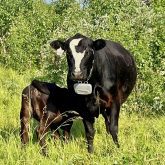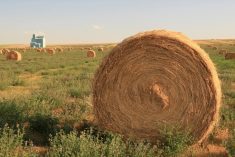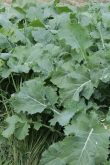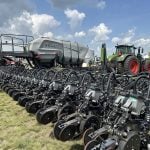I first met Dr. Alex Johnston, one of Canada’s leading range management scientists, at a 4-H camp that I was helping to lead in a wilderness area in the mountains north of Pincher Creek, Alta., many years ago. He was an impressive figure, dressed in his ceremonial headdress, given to him when he was inducted into the Kainai chieftainship and given the name of “Rainy Chief” or “Sotaina.” Johnston was a renowned research scientist at the Agriculture Canada Research Centre in Lethbridge, Alta., and a well-known historian of southern Alberta. During his presentation to the 4-H campers, he spoke about the history of the rangelands of Western Canada and how the Indigenous people of long ago managed these native lands.
Roots and pasture renos
In later years, I became more aware of Johnston’s range management research and his sound approach to resource management. In 1960 he published a very important paper in the Canadian Journal of Plant Science, where he grew rough fescue grass in a greenhouse study and cut the plants at different intervals of time. Some plants were left uncut until 16 weeks of growth. Other plants were clipped to five-, three- and 1.5-inch stubble height at four-week intervals. At the end of the study, Johnston measured the root mass under each clipping height.
Read Also

The Canadian Cattle Association’s international advocacy efforts
Global ag policies affect Canadian food policy, so the Canadian Cattle Association participates in international and domestic forums
He found the different herbage removal rates were damaging to the individual range plants. Clipping to a stubble height of five inches, which was similar to 20 per cent grazing utilization, resulted in a considerable root mass reduction compared to the unclipped or season-long control. Tiller production was vigorous when plants were clipped to the five-inch stubble height but was greatly reduced when plants were clipped to three-inch stubble height. The yield of both top and root growth declined as the severity of clipping increased.
Years later, Lorne Klein saw Johnston’s root pictures from the greenhouse study. Klein, a forage specialist with Saskatchewan Agriculture in Weyburn, then did two similar clipping trials in the field. In 2004, he planted crested wheatgrass, smooth bromegrass and meadow bromegrass in 10-inch diameter tubes in the ground. The plants were watered and over three years he clipped the forage once a year in early July, twice a year in June and August, or multiple times during the year.
After three years, Klein found that all grasses that were clipped multiple times a year had considerably less root mass than those clipped once or twice a year. In 2008-2012, he did a similar field trial and found the same thing — frequent clipping drastically reduced the root material in the soil.

This idea of once-a-year grazing can be used to renovate depleted pastures. Years ago, at Melfort, Sask., we were able to rejuvenate a worn-out community pasture area at Pathlow by deferring grazing until late fall. We did this for a couple of years and were able to bring back the pasture sward to a productive level without having to break and reseed. We basically restored root systems by allowing for a season-long growing period.
Surviving drought
So, what does all this mean to grazing managers, especially in times of drought? The number of live roots drives the grazing system.
“In times of drought, if the soils are deeply penetrated by fine roots, there is additional water available to the plants,” says Dr. Shabtai Bittman, research scientist with Agriculture Canada formerly at Melfort, Sask., and currently at Agassiz, B.C. “Many of the common forage grasses are well-adapted to extended periods of drought.”
For example, crested wheatgrass and orchardgrass have survived at least 22 months of drought in the Israeli desert, Bittman says. He attributes this to deep roots and the plant’s ability to shut down growth during drought, then respond when conditions improve.
Bittman defines some commonly used terms. Drought tolerance is the plant’s ability to maintain growth through a water shortage. Drought resistance is the ability to survive without growth through dry periods. Water use efficiency refers to water resource optimization, “or the amount of forage yield produced with a given amount of water,” says Bittman. Stomatal closure in leaves “is the first level of defence against desiccation” during drought, he adds.
“In work we did at the Melfort Research Station many years ago, we found that some grasses have different drought-resistant strategies. Crested wheatgrass grows earlier in the spring and has a greater tendency for leaf senescence than does smooth bromegrass.”
Leaf senescence reduces evaporative surface area, conserving water, he says. But, they also found that non-floral tillers tended to stay green much longer than floral tillers.
“This suggested that the leaf senescence response to water deficits was related more to conserving nutrients and less to conserving water. The floral tillers with more rapid senescence mobilized plant nutrients towards seed production. Ample seed production is often observed in periods of stress.”
Forage grasses mainly operate in shallow soil depths of six to 10 inches. Some specialty grasses, such as Altai wild rye, have deep roots and were not drought-adapted otherwise. The Altai wild rye looked great when there was deep moisture. But if that moisture ran out, it could die.
“It should be planted around sloughs which I am guessing is where it came from. It is moderately salt tolerant,” says Bittman.
Deep roots are needed for the grass’s survival, but don’t contribute much to yield, as intermittent summer showers only soak the soil surface.
“Some high-producing grasses are shallow-rooted, like perennial ryegrass., which is why they easily dry up in summer compared to alfalfa with tap roots. However, the grasses don’t die because they have some deep roots and the clay soil particles release water gradually.”

Such grasses are “opportunistic water users,” using moisture when it rains. Crested wheatgrass also grows early, using water more efficiently in cool spring weather. Later, “leaves roll, stomata close and plants go dormant quickly.”
Drought improves nutritional quality of crested wheatgrass because lignin has less chance of forming and carrying capacity may be better than expected. Protein is low since the protein/nitrogen is mobilized to the plant base. Alfalfa can’t compete with grasses for short rains but water that gets past fibrous grass roots is available to the alfalfa’s taproots. Alfalfa is a big water user. It needs lots of irrigation and dries out soils badly during drought.
Sandy soils don’t hold much water, but water is easily available for as long as it lasts. Clay soils don’t give up their water so there is always some left, and slow growth continues into drought. Plants with deep roots can last a long time on clay-rich soils since there is always a bit more water left for slow uptake and survival. In contrast, even semi-arid grasses can die in sandy soils with prolonged drought. Deep roots are especially good for perched water tables or low spots, such as those near sloughs.
Managing for drought
Plant litter plays an important role in effectively using rainfall and soil moisture. In the early days, Dr. Johnston and later Dr. Walter Willms, a retired range ecologist at the Agriculture Canada Lethbridge Research Centre, found that reducing surface residue in the form of carryover forage increased soil moisture evaporation in the summer and reduced snow catch during the winter. This resulted in less soil water to support future plant growth. As grazing intensity increased, water intake and water-holding capacity of the soil declined, resulting in more runoff. Litter enhanced forage production by improving moisture infiltration, and reduced soil temperature and evapotranspiration. Without adequate litter or mulch, forage yields will be greatly reduced during drought.
“Rotational grazing works when you have the potential for regrowth. That is the basis for exploiting the rest period,” says Willms. “Tufted species like we have on the southern Prairie grasslands have a more determinate growth habit while rhizomatous species exhibit one that is more indeterminate, therefore able to regrow after grazing, providing soil moisture is adequate.”
Grazing may stimulate regrowth by removing self-shading, he adds, which can be a factor when the leaf area index is greater than one. Leaf area index is the ratio of area of leaves over a unit area of land.
He expects rotational grazing to work best in areas where grassland is dominated by rhizomatous species, such as the northern part of the northern Great Plains. But it would be less effective where tufted species dominate, such as in the mixed prairie or the southern part of the northern Great Plains.
“You need both water and species capable of utilizing the water for a rotational grazing system to work — and during drought conditions, you don’t have water.”
A grazing system that depends on plant regrowth to maintain a healthy grassland won’t work during drought because it lacks water for regrowth, Willms says.
“Depending on the severity of drought, this is probably true for any region in Canada but especially for the mixed prairie, where plants are adapted to summer drought which occurs in most years by senescing. Drought would simply exacerbate that.”
No grazing system can overcome lack of soil moisture, leaving ranchers managing for the future by reducing grazing pressure, he adds. “There is no point in implementing a grazing system during drought but rather taking steps to reduce grazing pressure by destocking, supplemental feeding or any other animal husbandry practice that takes animals off the grassland.”
Ranchers on the Great Plains should always be managing for the next drought, Willms says. “This is done by ensuring a healthy grassland and managing a supply of emergency feed.”
The rest period should allow the plants to regrow after grazing to replenish their energy reserves and re-establish leaf area. But a longer rest period when plants are not growing, and possibly senesced, will not benefit recovery.
The problem on the dry mixed prairie of southern Alberta and Saskatchewan is the growing season is very short. However, it gets longer as we go north. High-intensity rotational grazing on the southern dry mixed prairie removes too much litter and exerts heavy grazing intensity, negatively affecting the grassland. This is only made worse by drought, and so it’s extremely important to reduce grazing pressure to match available forage, says Willms.
“The most important consideration with respect to grazing in any part of Canada is grazing pressure. This is true for any growing conditions and under any grazing system, but especially during drought,” says Willms.
Litter is especially important during drought, but for litter to have any effect, there must be water in the soil, he adds. Litter provides other benefits, he says, such as emergency feed. It also helps maintain the structural heterogeneity of the plant community, which helps with snow capture, he adds.
In times of drought, it is extremely important to manage grazing systems to fully use all available moisture and sustain the forage mixture, no matter where you are. Reducing stocking during periods of drought to ease grazing pressure cannot be emphasized enough. Stocking rates must match the available forage. Sufficient rest times between grazing periods are also key to grassland sustainability. The rest period must occur when forage plants are actively regrowing. During drought, when regrowth is very slow, extend the rest period. It should be longer compared to times with adequate moisture when regrowth is rapid.
The clipping studies demonstrate the need for rest periods to enable adequate root development. The traditional method of continuous grazing old-seeded pastures will not be sustainable in drought conditions. A rest period when plants are regrowing must be available.
In the late 1960s and 1970s, some of the first rotational grazing work was done at the Ag Canada Melfort Research Centre. A simple four-paddock system was used. Today, many graziers are using multiple paddocks in their grazing systems during times of drought.
At the recent Canadian Forage and Grassland Association annual conference, attendees raised concerns about the slow adoption of rotational grazing. The cost and lack of knowledge were cited as some of the barriers by producers. There is a wealth of research information on how to implement rotational grazing on your grazing lands available from the Beef Cattle Research Council (beefresearch.ca), Canadian Forage and Grassland Association (canadianfga.ca) and provincial forage associations. Producers can access federal funds through various provincial agencies to develop a rotational grazing system. All of this will help maintain grazing lands through times of drought.
Back to history. Dr. Alex Johnston, the renowned historian and range management researcher, was given an honorary doctor of laws degree by the University of Lethbridge in 1976 and was inducted into the Alberta Order of Excellence in 1984 for his research and historical writing. The University of Lethbridge celebrates his life’s work every year with the annual Alex Johnston lecture series. A fitting tribute to a great man.
















